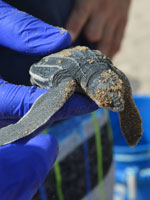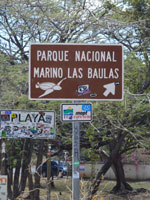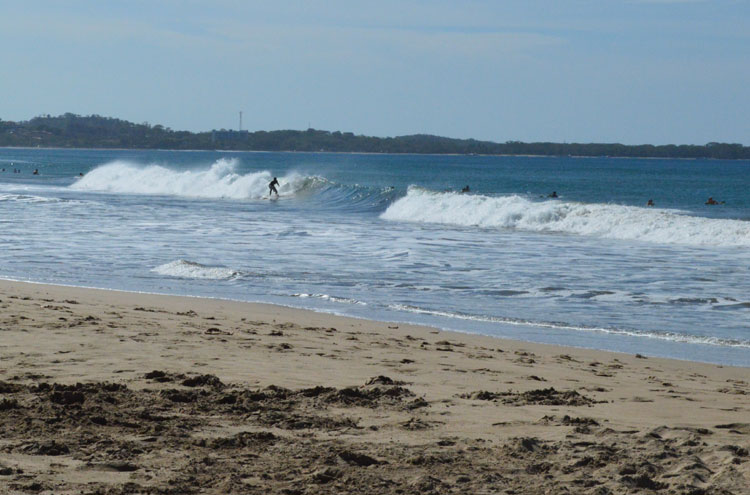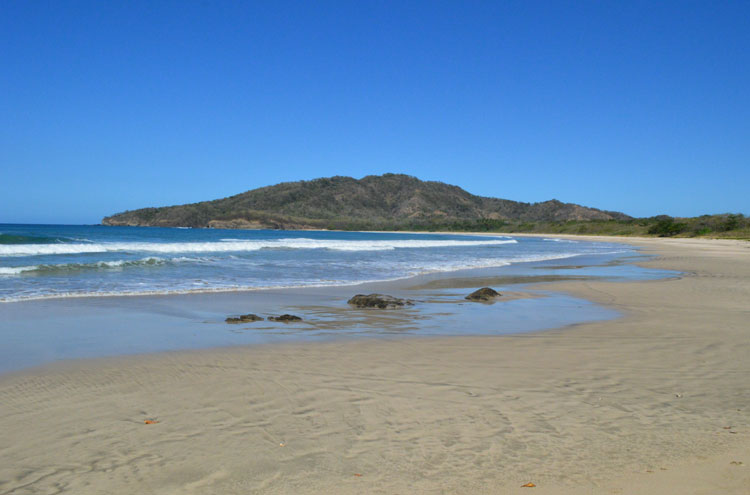

|
What better way to start a day than with a cup of strong Costa Rican coffee. This was followed by a nice morning walk up Playa Grande to Playa Ventanas with Laura, one of my fellow volunteers. It was amazing how different Playa Grande was in the morning. Surfers were riding the waves and families with children were running through the sands where we had been monitoring turtles the night before. The sun was beating down on us with a ferocity that was tempered only slightly by a light breeze.  Playa Grande is a very different place in the daytime At the northern end of Playa Grande, a large rock stands just offshore, forming a gateway to Playa Ventanas. We went through this gateway and saw the splendor of serene and isolated Playa Ventanas spread out before us. Very few people venture this far up the beach, so it has a completely different atmosphere than Playa Grande. It curves around a small bay, with a small promontory at the far end of the beach. It looks and feels like paradise.  Playa Ventanas Back at the station, all the volunteers gathered for a presentation by Dr. Frank Paladino, who started the leatherback conservation project here 25 years ago. Our team was really lucky that Frank happened to be here during our expedition, because he is not here all the time. He gave us an overview of how the project started, the challenges it has faced, and where we go from here. It is incredible to realize that the leatherback turtle species came so close to extinction back in the early 1990s, when the population declined by more than 90% in just a few years. Egg poaching was carried out on an industrial scale, and almost all eggs that were laid on the beach were harvested by poachers from nearby villages. Over time, many of the former poachers have been transformed into conservationists, aiding in the project by working as tour guides and educators about leatherback turtles. The leatherback turtle population still faces a number of hurdles before it can recover to former levels. Hatchlings are vulnerable to predation; by raccoons while they are in the nest, by vultures when they are on their way to the sea, and by fish once they reach the ocean. As they grow bigger, they become entangled in fishing lines and netting, injured by fishing hooks, brought up as bycatch by fishermen, and have to make their way across an ocean that is crowded with shipping traffic. If the turtles reach maturity and try to return to the beach where they were born to lay eggs, they face a confusing array of lights that have sprung up from development along coastal areas. They are hard-wired to seek out the safety of dark isolated places on the beach, so the bright lights of beach homes and hotels can be a daunting challenge to overcome. Thus the work that that has been done over the past two decades to protect this species is only resulting in maintaining a steady population. As of yet, there has not been a significant recovery. After the presentation, I went out to the Hatchery with Chris and a few of the other volunteers to conduct an excavation of one of the leatherback nests. The Hatchery is a small enclosed space, just inland from the beach, that is used to relocate nests that were originally dug in bad locations. A leatherback sea turtle is not going to know that she is laying her eggs right in the middle of the major path that leads to the beach or right next to an entrance to the beach. Sometimes she will not make it far enough up the beach, leaving the eggs vulnerable to a high tide. These types of nests are identified, dug up, and relocated to the Hatchery.
We start the excavation on one of about 20 recovered nests in the Hatchery. The hatchlings had emerged from this nest a couple of days ago, but we still needed to dig up the nest to see if there are any hatchlings that didn't make it out on their own but might still be alive. Chris showed us how to carefully dig up the nest, taking care to not harm any hatchlings in the process. One by one Chris pulled up a few struggling hatchlings, caked in sand, but still very much alive. We placed them in a bucket for release later that night. A few of the surviving hatchlings after they were dug out of the nest. The rest of the excavation consisted of pulling out the remaining eggs and classifying them based on their condition. Some of them were mere pieces of shells, while others were collapsed eggs that were never viable. There was one that seemed like it was still in decent condition, but examining it on the inside revealed a dead hatchling wrapped around a small piece of yolk. All of this data was recorded into a notebook, including the depth of each find, the condition of the hatchling or egg, and the total number of recovered hatchlings or eggs. We conducted the excavation in the middle of the afternoon, so it was very hot at the Hatchery, which is an open area set back a short distance from the beach. While we were working, a few tourists walked by and watched us curiously. Some of them asked us questions and we took the time to explain what we were doing and why it is important. Little by little, more people began to appear and soon there was a large crowd gathered around the perimeter of the Hatchery. We were happy to answer their questions, because education is an important part of preventing the extinction of a species. As we finished up our work, the crowd seemed inspired, many of them eager to take a nighttime Turtle Tour. The money generated from the tours helps to finance the work of the Leatherback Trust, so we accomplished a number of different tasks during this excavation. My second night on beach patrol was a little quieter than the first. I was assigned to patrol Playa Ventanas with Shannon, another one of the biologists. We started off the night by doing guard duty at the Hatchery, where the main threat is raccoons. I didn't see any, but was told to watch out for their glowing eyes shining out from the depths of the forest. After an hour of guard duty, Shannon and I were relieved by another team, so we began our patrol up the northern end of Playa Grande and onto Playa Ventanas. This was the same walk I had done earlier that morning, but it was completely different at night. The stars above were even brighter than before as we got further and further away from the lights of Tamarindo. We didn't come across any turtles, but at one point we heard a loud continuous crackling sound a few feet ahead of us. We turned on our red headlamps and saw an amazing sight. Hundreds and hundreds of hermit crabs were having a massive beach party, dancing around in the sand, clicking their claws, and forming a three-foot wide highway that we gingerly crossed. After the first patrol to the northern end of Playa Ventanas, we returned to the Hatchery to another shift of guard duty. Our relief was delayed however, when they came upon a baula on the south end of Playa Grande. There were two baulas that came up onto the beach that night, although I was not on the teams patrolling those sections of beach. Neither of the turtles was able to successfully nest; they dug around in the sand, but then aborted the nest and returned to the sea. When Shannon and I left the Hatchery to do another patrol up to Playa Ventanas, we immediately came upon an olive ridley rapidly making her way back to the ocean. While we were doing our guard duty, she emerged from the sea, came up the beach, built her nest, and laid her eggs, all just a few meters away from where we had been. This kind of stealth movement is essential to sea turtles' survival, so we had to chalk it up to nature pulling a fast one on us. |
||||
|
||||
|
© 2015 Michael Hanrahan
|